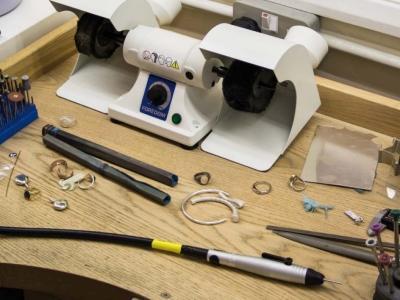Whatever stage you’ve reached in your jewellery making career, you’ll know that one of the most invaluable tools available to you is the flex shaft tool (also known as a ‘pendant motor’ and ‘flexible shaft rotary tool’, among many other things!).
As a fundamental part of any professional jeweller’s toolkit, it’s worth figuring out which type of flex shaft tool fits your style of work and your preferred methods of production.
That’s why we’re shining a spotlight on the Foredom pendant motors and accompanying Foredom attachments. Hopefully our guide will give you a clearer idea of whether they are the right choice and provide you with more information on how to get the most out of these tools. Discover which Foredom flex shaft tool you need for your projects below, and get started with building your Foredom flex shaft jewellery kit.
Which Foredom flex shaft tools should I buy?
About the Foredom flex shaft motor


Foredom has produced flexible shaft tools since 1922 and has developed a tool for professional jewellers that is unparalleled in its power and versatility.
What’s more, the range of powerful Foredom motors are capable of fast speeds – perfect for tight deadlines. For example, the SR motor reaches speeds of up to 18,000 RPM (1/6 horse power), and more torque than any other pendant motor on the market.
The power and speed of Foredom flex shaft tools mean that you can work on any kind of project with ease, and due to its performance, the tool will not waiver or falter under normal load – making Foredom flex shaft maintenance easy.
In the long run, a Foredom motor will become one of the most important tools in your workshop, because of its versatility and performance
Foredom flex shaft tool: your set up


The Foredom handpiece and motor are often sold separately, however they are connected via an inner cable (usually about 3ft long), which means the motor must be hung at the bench using a stand. It is important to use the shaft at a gradual curve rather than ‘pig-tailed’ as it could get damaged, and it is recommended that you hang your motor approximately 2ft from your workspace. For those that do not have space, Foredom have also introduced table top rotary micromotors.
Controlling the speed of the Foredom flex shaft tool couldn’t be easier when using a foot pedal. This helps you manage the speed of the tool as you work without having to worry about balancing the weight of the handpiece, as well as a speed slider. For those that would prefer, Foredom also offers a dial control unit; a table top speed control (suitable for SR motors only).
How does a Foredom flex shaft rotary tool work?
There are a variety of Foredom jewellery tools that you’ll want to explore before settling on one. The industry standard SR motor for general use is the most popular motor, and the LX motor (a high torque, low speed option) is ideal for specialist applications such as stone setting, wax modelling and pearl drilling.
Foredom carries both – the fixed handpiece system and interchangeable handpiece system.
Fixed Foredom Flex Shaft handpiece
This means the handpiece can be removed from the end of the shaft;, however, the chuck cannot be changed as it is fixed in place. So, you cannot change the size of the chuck and this handpiece will only be suitable for the specified shanked Foredom attachments – in our case, 2.35mm shanked accessories. However, you’ll be able to change the handpiece for a quick release as this connects to the shaft. This does make the process of switching burrs a little longer, but if you primarily work with one type of burr over long periods of time this system could be effective for you.
Interchangeable Foredome Flex Shaft handpiece
Unlike the fixed handpiece system, an interchangeable system means that you can alter the types of handpieces you need to use as and when you like. Whether that’s for stone setting, engraving or polishing. And as you develop your skills, you’ll find the versatility of an interchangeable handpiece incredibly useful.
Quick release system
In addition to finding a handpiece that works for you, choosing one with a quick release system can also speed up your manufacturing process.
The quick release lever tightens or loosens burrs interchangeably in a matter of seconds. All you have to do is push the lever to release, change out the burr you’re using, and then push the lever back into its original position to tighten the burr in place. This is a real time saver. With no need to remember where you’ve put a chuck key or pin and wrench, the quick release system saves you valuable time in the workshop.
Foredom flex shaft parts: where to start


If you’ve already settled on a Foredom flex shaft tool, then you may be wondering where to start with the accessories – there are so many to choose from so it’s worth investigating which Foredom flex shaft accessories will most benefit your area of expertise.
Here’s an idea of which accessories to pick up and which jewellery making skills they align with:
- Cutting discs are ideal for cutting smaller pieces of metal or removing sprues from castings
- Drill bits for creating holes with ease
- Burrs for engraving or setting
- Abrasive sanding discs and rubber cylinders for polishing and pre-polishing
- Wire mops and wheels for adding an interesting surface texture
- Soft fabric mops for polishing to a high shine
Want to know more about which Foredom to buy? Take a look at our Foredom jewellery tools range and download the Foredom catalogue for an in-depth look at the Foredom SR series and the Foredom LX series pendant motors.


Cooksongold

